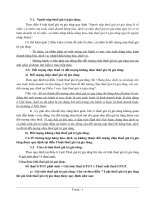bài giảng semantics & pragmatics
Bạn đang xem bản rút gọn của tài liệu. Xem và tải ngay bản đầy đủ của tài liệu tại đây (611.78 KB, 118 trang )
Học phần
Semantics & Pragmatics
Ngữ nghĩa học& Ngữ dụng học
2 ĐVHT
Giáo viên: Phạm Thị Hải Trang
Lớp: 53 BPD 1&2
Khoa Ngoại Ngữ
Lecture 1
Conceptual & Associative
meaning
(Denotation & Connotation)
Conceptual & Associative meaning
• Conceptual meaning/ literal meaning/
denotative meaning: basic meaning in the
dictionary
• Associative meaning/ figurative meaning/
connotative meaning: additional meaning
to show people’s emotions or attitude
Ex: a needle
• “thin”, “sharp”, “steel” instrument
• “pain”, “drugs”, “blood”, “thread”, “knitting”
• Low-calorie
– “Produce a small amount of heat and energy”
– “Healthy”
• Trắng
– “Có màu sáng như màu của vôi, bông”
– “Đẹp”, “mướt”
white
How to find the associative
meaning of a word?
• The culture in which the word is used
• The language user’s family or
educational background
• The language user’s social or political
class
• The language user’s speech community
or ethnic group.
• Man
– Human beings
• Woman
– Devoted, patient, beautiful, attractive
– Talkative, wicked, destructive, spoiled
• Fox
– Cunning, deceitful
• Slim
– Charming, nice
Exercise 1:What kind of connotation
does each word below has?
• Woman/ Mother/ witch
• The old man/ man/ father
• Slender/ skinny/ thin
• Plump/ overweight/ fat
• Stingy/Frugal
• Pushy/ Aggressive
Exercise 1:What kind of connotation
does each word below has?
• Woman/ Mother/ witch
• The old man/ man/ father
• Slender/ skinny/ thin
• Plump/ overweight/ fat
• Stingy/Frugal
• Pushy/ Aggressive
– Positive connotations:
• mother, father, slender, plump, frugal
– Negative connotations:
• witch, the old man, fat, stingy, pushy
– Neutral connotations:
• woman, man, thin, overweight
Exercise 2
1. Which word below may be considered old-fashioned:
stewardess or flight attendant?
2. Which word below is considered old-fashioned in
everyday speech: automobile or car?
3. Which word below has a more negative connotation:
cautious or cowardly?
4. Which word below can suggest a lack of politeness: bold
or adventurous?
5. Which word below would describe a person appear in a
painting: naked or nude?
6. Which word below suggests a higher level of skill and
training: career or job?
Lecture 2
Semantic features
Semantic features/
Semantic components/ semantic properties
• The crucial element/ feature of meaning/
the basic conceptual meaning
• Ex: Child
– [+human], [+young],[+/- male], [+innocent]
Common semantic features:
– Plus (+)
– Minus (-)
[+ animate] [- animate]
[+ human] [- human]
[+ female] [- female]
[+ adult] [- adult]
Why do we need to study the basic
conceptual meaning?
To differentiate the meaning of each word
in a language from every single word.
Girl
[+human], [+female], [-adult]
Woman
[+human], [+female], [+adult]
To account for the ‘oddness’.
The hamburger ate the boy.
–hamburger
• [-animate], [-eating]
–boy
• [+animate], [+eating]
• Can the same semantic feature be part of the
meaning of many different words?
– Yes, it can.
– Doctor, teacher, engineer, tailor all share the
same semantic feature [+professional]
• Can the same semantic feature occur in words
of different parts of speech?
– Yes, it can
– Mother (n) [+female]
– Pregnant (a) [+female]
Semantic fields
Related semantically similar items
• Items related by topics
– Types of fruit: apples, oranges, grapes
• Items which are similar in meaning
– Ways of walking: tiptoe, plod, limp
• Items which form pairs of antonyms/ synonyms
– Old/new, long/short
– Fix/repair/mend
• Items grouped as an activity or a process
– Do the housework: clean the rooms, do the washing
Exercise 1: Use the semantic features, how
would you explain the oddness of these sentences
• The television drank my water.
• His dog writes poetry.
– The verb drink requires a subject with the
feature [+animate] and the noun television
has the feature [-animate].
– The verb write requires a subject with the
feature [+human] and the noun dog has
the feature [-human]
Exercise 2 :identify the semantic features
• Bachelor
• Spinster
• Hen
• Chick
• Pine
(tree)
• Oak (tree)
Exercise 2 :identify the semantic features
• Bachelor
• Spinster
• Hen
• Chick
• Pine (tree)
• Oak (tree)
• [+human], [+mature], [+male], [+stay
single]
• [+human], [+mature], [-male], [+stay
single]
• [+animate], [+bird], [+fowl], [+fully
grown], [+female]
• [+animate], [+bird], [+fowl], [-fully
grown], [+-male]
• [+plant], [+evergreen tree], [+needle-
shaped leaves], [+pale soft wood]
• [+plant], [+deciduous tree], [+tough
hard wood]
Exercise 3: identify the semantic
features in each of the following words
• Aunt
• Flower
• Owe
• Maid
• Actress
• Honesty
• Computer
• Beauty
Homework
identify the semantic features of the following words
plod
tiptoe
ewe
elm
doe
Lecture 3
Semantic roles
Semantic roles
• We may think of a word as ‘containers’ of
meaning.
• We can also look at the ‘roles’ they fulfill
within the situation described by a
sentence.
ex:
The boy kicked the ball.
Discussion
• 1. What is the other word for semantic roles?
– Thematic roles
• 2. How many semantic roles do we have? What
are they? Give examples (not examples in the
book) for each type.
– There are 7 roles
– They are: Agent, theme, instrument, experiencer,
location, source and goal
• 3. What does ‘entity’ mean?
– People or things (noun phrases)



